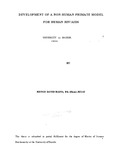| dc.description.abstract | HIV infection and the resultant disease, AIDS poses a big threat to humans world
wide and an enormous challenge to scientists and healthcare workers. The causative agent of
AIDS has been isolated and molecularly characterised. In addition reliable diagnostic
procedures have been developed. Inspite of these, events leading to disease have not been
well understood. What is responsible for the long latency of the virus in some individuals and
rapid disease progression in others upon infection is still an enigma that has to be elucidated.
The mechanism of immunosupression and tissue damage following lentiviral infection in a
host are complex. Investigation of HIV pathogenesis in vivo in humans is hampered by
important practical and ethical constraints.
The discovery of HIV-like viruses in non-human primates has opened up new avenues
in research geared towards the understanding of the biology and pathologenesis of HIV
IAIDS using these animals as models for studying HIV pathogenesis. The precise identity of
infected cells, factors that increase virus production and mechanisms of virus induced
immunodeficiency in vivo can effectively be-elucidated in such experimental animal models and
the results can then be extrapolated to address key and unanswered aspects of human
disease.
In the recent past, a lot of efforts have been directed towards development of suitable
animal models that can be used in HIV studies. In addition, such models can be used in
testing the efficacy of vaccine candidates and chemotherapeutic agents. Studies using nonhuman
primates naturally infected with an HIV-like lentivirus have shown that such animals
could give the answer to the long sought model. This project was aimed at developing De
Brazza's monkeys (Cercopithecus neglectus) naturally infected with an HIV-like virus as a
model for HIV/AIDS in humans. To achieve this, wild caught or colony born De Brazza's
monkeys Cercopithecus neglectus in-housed in a semi-breeding colony at the Institute of
Primate Research (IPR) , Kenya were tested for anti-SIV antibodies using antibody ELISA. | en |

